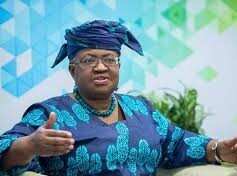The World Trade Organization (WTO) warned that global trade is likely to decline this year due to President Donald Trump’s tariff policies, which could have “severe negative consequences” for the world economy. Since taking office, Trump has implemented a 10 percent tariff on various imports and 25 percent tariffs on steel, aluminum, and automobiles. Although he has reversed plans for higher tariffs on several countries, he has intensified a trade conflict with China, imposing a hefty 145 percent tariff on Chinese goods, prompting China to retaliate with a 125 percent duty on U.S. products.
WTO chief Ngozi Okonjo-Iweala expressed significant concern, predicting an 81 percent drop in trade volumes between the U.S. and China. She highlighted that the ongoing trade uncertainty could hinder global economic growth, particularly affecting vulnerable economies. Initially, the WTO had anticipated trade growth in 2025 and 2026, but its latest global trade outlook indicates a 0.2 percent decrease in merchandise trade for this year, with only a modest 2.5 percent recovery expected in 2026. The projections for 2025 have already been adjusted downward by nearly three percentage points due to current tariff impacts.
The World Trade Organization (WTO) warned of “severe downside risks” that could lead to a further contraction of global trade, potentially shrinking by 1.5 percent in 2025 if conditions worsen. Although services trade is not directly affected by tariffs, it is also expected to suffer negative impacts, with commercial services trade projected to grow by only 4 percent—around one percentage point lower than previously predicted.
The WTO’s analysis indicates that the effects of tariffs will vary by region. In North America, exports are expected to decline by 12.6 percent, while imports could drop by 9.6 percent by 2025, negatively impacting global merchandise trade growth. In contrast, Asia is anticipated to see modest growth, with both exports and imports increasing by 1.6 percent. Chinese merchandise exports are projected to rise between 4 and 9 percent in regions outside North America, as trade patterns shift. Additionally, European exports are expected to grow by 1 percent and imports by 1.9 percent.
The World Trade Organization (WTO) forecasts global GDP growth of 2.2 percent for this year and 2.4 percent for 2026. While the organization believes that the immediate effects of tit-for-tat tariffs will be “limited,” WTO chief Ngozi Okonjo-Iweala warned that the significant decline in U.S.-China trade could have more serious implications. Although U.S.-China trade makes up only about 3 percent of global merchandise trade, she indicated that a continued decoupling of these economies could result in a broader fragmentation of the global economy into two geopolitical blocs. This fragmentation could potentially reduce global GDP by nearly 7 percent by 2040, which she described as a substantial impact.
In light of these challenges, Okonjo-Iweala called for reforms within the WTO, emphasizing the need to “inject dynamism” into the organization. She urged for streamlined decision-making processes and adaptations of agreements to align better with current global realities, stating, “We shouldn’t waste this crisis.”
